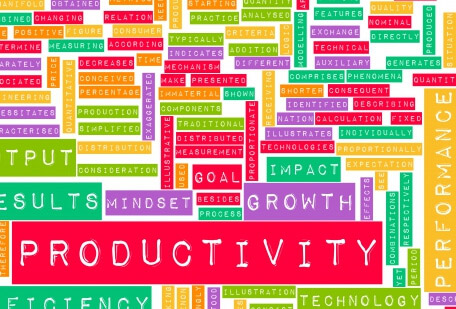How to Improve Productivity in a Sluggish Workplace

When workplace productivity flounders, it is easy to give in and let the sluggish behavior drag out, leading to flat or declining results from the staff. If you notice a lazy attitude taking hold in your office, a quick response can save your office and refresh the staff’s energy.
Stop sluggish behavior from occurring with these tips for increasing workplace productivity.
Get to Know Employees to Understand Motivations
Motivations vary for individual employees. While some younger employees may work harder for a raise or bonus, some of the more family-oriented employees are motivated by extra time off. Rewarding employees with bonuses or additional paid vacation days is a great way to show you know what’s important to your staff. Understanding employee motivation lets you structure a support system that tailors to each employee’s unique interests, inspiring them to work hard and achieve company goals.
Create a Comfortable Workplace Environment
Employees should always feel like they can come to you with any problems or questions they may have. Without this secure environment, employees may begin to feel their individual concerns do not matter to the company and, in turn, begin to care less about their work.
To foster your employee-employer relationship, create an atmosphere that emphasizes confidentiality and positive results. Your staff should never feel like this relationship is an imposition, and when an employee voices a problem, respond immediately to the situation. Outline a plan of action with the employee and make sure they know that you take your working relationship seriously.
In addition, demonstrate your support for every employee, not just the most valuable members of the team. Your employees should not feel like you are picking favorites. A manager that does not equally value their team members will quickly lose the respect of the ignored employees, resulting in a lack of desire to succeed. Build a strong relationship with each employee to create an office environment that is founded in trust and your employees will show their appreciation through hard work.
Constantly Reinforce Training
Training keeps employees’ skills sharp and shows you are invested in their success. When training is ignored, people often fail to follow standard guidelines, choosing instead to create their own shortcuts that may produce less than perfect results. By reinforcing training on a regular basis, you keep your team’s work on track and standardize expectations.
Regular training instills confidence and a sense of purpose for your employees. When people feel uncomfortable and unsure of the work they are doing, they sometimes procrastinate instead of asking for help. This leads to often-used excuses like, “I thought someone else did that,” or “I wasn’t sure how to proceed so I decided to wait and discuss it with you first.” Implementing regular training sessions gives employees confidence and prevents sluggish behavior from taking root.
Make Sure Staff Has Adequate Training and Supplies
Employees need all the necessary resources to succeed. If they do not have these tools and supplies, you are setting them up to fail. Check in with employees frequently to ensure needs are being met by management and the company overall. Listen to employees, and then make a judgment call on whether their requests are sound, or if they can reasonably be expected to succeed with the industry tools already provided by the company.
Schedule Time for Minimal Interruptions
Actively encourage employees to block off parts of their days as “uninterrupted time.” This means no phone calls, meetings, text messages, or anything else that could distract them from meeting deadlines. In today’s technology-driven world, it is easy to become distracted and procrastinate on projects. By setting aside periods to focus solely on work, employees avoid distractions that waste time.
Avoid scheduling unnecessary meetings that may cut in to productive work time. A common response to a perceived sluggish atmosphere is to schedule office-wide meetings to discuss productivity. This, however, is actually counterproductive. Effective solutions rarely come out of incessant meetings.
Provide Clear Feedback
Let employees know when they are not meeting expectations and give clear direction on how they can improve. Sometimes, employees are not even aware that their performance is lacking. Silently stewing about an employee’s performance benefits no one. Schedule a quick meeting to clearly explain performance issues and ways the situation can be rectified.
Once the employee begins to show improvement, be generous with your praise. When employees feel proud of their work, they will work harder to replicate positive results. If improvement does not occur in their work, meet again to discuss possible problems affecting their work. Giving employees the chance to explain the reasons behind their behavior strengthens your professional and personal relationship, leading to a desire to improve performance results.
Use Small Incentives to Reward Hardworking Employees
Unexpected surprises create healthy workplace competition and motivate employees to work harder. Once you have taken the time to understand what motivates your employees, set up incentives accordingly. Even giving a small reward like a gift card to the local coffee shop or a personalized certificate shows that you took the time to notice an employee’s hard work. Anything that conveys your appreciation will disrupt a sluggish workplace and improve office productivity.
Be a Role Model
A workforce mirrors the supervisor. As a leader, you should work as hard as you expect your employees to work. When managers begin to slack off, employees feel they can follow suit. Set a good example and demonstrate the level of effort you expect from your team.
Allow Brain Breaks
Remember that your employees need regular breaks to stay productive. Without these breaks, employees can begin to feel burned out, and their work suffers. Twenty minutes of down time can sometimes produce two hours of extremely productive work.
Managers often feel their employees should be working every single minute, but it is important to understand that a break actually improves productivity. Let your team know that you understand the need for a little mental break. This shows your employees that you trust their time management skills and this will boost morale, leading to a more productive office.
Slumps in productivity occur at some point in every office. A great leader accepts that employees are not able to maintain a 100% effort 100% of the time. An effective manager will utilize these tactics to help their team bounce back from idle behavior and improve overall results. Try a few of these tips to revive productivity in your staff.







